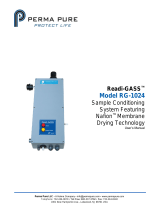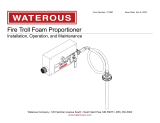Page is loading ...

Foam Generator
Setup Guide
Smoke Ejector / PPV
Super Vacuum MFG. Co., Inc.
3842 Redman Dr
Fort Collins, CO 80524
(800)525-5224
www.supervac.com

SUPERVAC INLINE EDUCTORS
These instructions are provided to allow safe and efficient use of this product. all personnel expected to use
this product should be trained with these recommended operating procedures.
Principles of Eductors
An Eductor is a device that uses the venturi principle to introduce a proportionate amount of liquid
concentrate into a water stream. This venturi principle is used in all Supervac eductors to induce foam or
other liquid agents into a fire control stream.
The venturi is the constricted portion of the waterway near the eductor inlet. This restricted passage increases
water velocity, thus momentarily reducing its pressure as it passes into the larger area of the induction
chamber. Concentrate is introduced into this reduced pressure area through a metering device. The venturi
orifice performs as a very efficient straight bore nozzle that is calibrated for a given flow at a given pressure.
Supervac eductors are calibrated to flow rated capacity at 200 p.s.i. (14 Kg / cm² ) inlet pressure and most
non-aspirating fog/straight stream nozzles achieve rated flow at 100 p.s.i. Eductor inlet pressure of 200 p.s.i.
(14 Kg / cm² ) is necessary to overcome significant friction loss through the venturi and additional friction
loss between the eductor and the nozzle. The nozzle must match the flow rate of the eductor. The eductor
controls the flow through the entire system. If inlet pressure is increased, the flow of water will increase and
if inlet pressure is decreased, the flow of water will decrease. As long as 200 p.s.i. (14 Kg / cm² ) inlet
pressure is maintained, the eductor will flow rated capacity, even with different nozzles and hose lays. Even
with no hose or nozzle connected to the eductor outlet. The exception is if the nozzle has a lesser rated flow
than the eductor. The nozzle will then take over control of the entire system and the eductor will not function
properly. Once the eductor has established the flow of water, the performance of the downstream portion of
the system will be determined by that flow. Friction loss through the eductor is not fixed.
Friction loss through the eductor can be calculated by subtracting the following three factors from the inlet
pressure:
a) nozzle pressure
b) hose friction loss between the eductor and the nozzle
c) any pressure change due to a difference in elevation between the eductor and the nozzle. The eductor
will pick up concentrate whenever the outlet pressure is less than 65% of the inlet pressure.
A metering device controls the flow of concentrate into the eductor. Atmospheric pressure acting on the
surface of the foam concentrate, in its container, pushes the concentrate into the pickup tube, through the
metering device and into the reduced pressure inlet chamber. Atmospheric pressure does not change, so the
flow of concentrate remains the same as long as the low pressure area is created. However the flow of water
will be different at different inlet pressures. Since the flow of concentrate remains the same but the flow of
water changes, the resulting solution will have different percentages of concentrate at different inlet
pressures.
The percentage shown on the metering device only applies at the correct eductor inlet pressure, 200 p.s.i. (14
Kg / cm² ) If the eductor is operated at less than 200 p.s.i. (14 Kg / cm² ) inlet pressure and thus a lower flow
of water through the unit, the resulting foam solution will have a higher percentage of concentrate. With inlet
pressure higher than 200 p.s.i. (14 Kg / cm² ) the foam solution will have a lower percentage of concentrate.

For example, an eductor which produces a concentration of exactly 6% at 200 p.s.i. (14 Kg / cm² ) inlet
pressure will produce the following concentrations at different pressures:
5.5% at 250 p.s.i. (17.6 Kg / cm² )
6.0% at 200 p.s.i. (14 Kg / cm² )
6.9% at 150 p.s.i. (10.5 Kg / cm² )
8.4% at 100 p.s.i. (7 Kg / cm² )

Basic Operating Instructions
1. Connect eductor to discharge outlet of apparatus.
2. Connect hose to discharge of eductor.
3. The eductor must be used with a nozzle having the same rated flow.
4. Open discharge and set proper flowing pressure. Eductor inlet pressure of 200 p.s.i. (14 Kg / cm² ) is
required for accurate proportioning of concentrate into the water stream and efficient nozzle
performance. Be sure that nozzle is fully open.
5. Insert pickup tube into foam supply. There will be a delay of 12 to 15 seconds before the foam
solution will be discharged at the nozzle in a typical system.
6. The hose lay between the eductor and the nozzle must not exceed the recommended length for the
combination of flow rate and hose size being used.
Important Reminder
Eductor inlet pressure must be 200 p.s.i. (14 Kg / cm² ) If correct pressure has been established and the
eductor fails to pick up concentrate, increasing the inlet pressure will not correct the problem. Increased inlet
pressure will increase water flow and thus nozzle pressure will also increase, creating excessive back-
pressure at the eductor venturi.

The inline foam eductor is to be attached directly to the SUPER-VAC foam generator. The safe
operating pressure of the pump, hose lines along with the required eductor operational pressure
must always be monitored by the operator.
It is extremely important to follow the manufacturer’s operating instructions regarding the inlet
pressures.
Hose line lengths and sizes between the eductor and the supply may cause the foam performance
to vary. The eductor employs a venturi principle which draws or drafts foam concentrates and
inducts them into the water stream mixing with the air produced by the fan, which produces a
finished foam solution.

Check List For Some Common Eductor Problems
Mismatched nozzle
The eductor will not pickup concentrate is the nozzle discharge rate is less than the eductor flow rate. If the
nozzle has variable gallonage settings, adjusting to the next higher flow rate should correct the problem. for
example from 95 g.p.m. ( 360 l.p.m.) to 125 g.p.m. ( 473 l.p.m.). While this procedure will usually allow the
eductor to pickup concentrate, the effective reach of the resulting stream will be slightly diminished because
of reduced nozzle pressure.
Partly closed nozzle
If nozzle shut off is not fully open, discharge flow rate will not be achieved. Nozzle pressure will increase.
Eductor will not function. The eductor will also fail if a variable flow nozzle is inadvertently set at a lower
gallonage than the eductor (i.e. from 95 down to 65 g.p.m.), again creating back pressure.
Clogged nozzle
If nozzle waterway is partly clogged with debris, it will not flow proper gallonage. Adjust nozzle to flush
position to clear foreign matter, then return to proper flow setting.
Nozzle elevated too far above eductor
The additional back pressure created by elevating the nozzle may cause eductor to fail. Keep in mind that
elevating the nozzle above the eductor will increase back pressure by 5 p.s.i. ( .4 Kg / cm² )for every
additional 10 feet ( 3 meters) of elevation. This condition would be quite obvious if the attack line is
advanced to upper levels of a structure. Extending the hose line up a hill such as a highway overpass, while
being less obvious, would still create the same back pressure increase.
Hose lay too long
Refer to chart recommending maximum hose lays for various eductor nozzle combinations. Increasing nozzle
flow rate, as suggested under “mismatched nozzles”, will compensate for a longer hose by reducing nozzle
pressure.
Ball check stuck
If the eductor has not been properly flushed, the dried concentrate may cause the ball check to stick closed.
This ball is located in the metering device immediately inside of the nipple which connects the pick-up tube
assembly to the eductor. By removing the clear plastic tubing from the nipple, the ball can be visually
inspected in the nipple opening. If it is stuck, it can be dislodged with a pencil or other blunt tool.
Clogged strainer
When flushing eductor system after use, be sure that strainer on end of pickup tube is also clean. The strainer
assembly threads on to the tube and can be removed for thorough cleaning. Concentrate will not be correctly
proportioned, even if strainer is only partly clogged.
Kink in hose
A restriction in the hose line can be dangerous under any conditions. When a kink occurs in the foam attack
line, not only does it restrict the discharge flow but it also completely stops the foam induction in to the water
stream. Back-up personnel should observe and prevent the hose from kinking.

Setup Instructions
Smoke Ejector kit includes:
Foam Generator
Eductor with pickup tube
Discharge Net
Setup:
1. Attach generator to 16 inch Super Vac Smoke Ejector discharge side.
2. Attach eductor to generator.
3. Secure discharge net to generator housing.
4. Insert pickup tube into foam
source.
5. Make necessary water supply
connection.
6. Refer to performance chart for
settings to achieve desired
results.

PPV kit includes
Foam Generator
Eductor with pickup tube
Discharge net
Spacers (2) for latch connection
Setup:
1. Align foam generator to
discharge side of ventilator with
support foot at bottom of unit.
2. Remove the 2 guard screws
from ventilator that line up with
latches on foam generator, insert
spacers and replace screws. This
will insure proper connection of
generator latch to ventilator
shroud.
3. Attach generator to ventilator.
4. Attach eductor to generator.
5. Secure discharge net to
generator housing.
6. Insert pick up tube into foam
source.
7. Make water supply connection.
8. Start ventilator adjust R.P.M. to
approx. 1/2 throttle (1700
R.P.M.).
9. Eductor is designed to operate at
a maximum of 200 p.s.i., but
will operate at anywhere from
50 p.s.i. to 200 p.s.i.
10. Hose length, hose size,
operating water supply pressures
as well as R.P.M. of ventilator
will all affect foam performance.
It is recommended to train and
adjust all of these variables to
achieve optimum foam
performance.

005-10247
008-14331
008-10228
018-10429
008-14330
008-14335
008-10221
005-10249
SMOKE EJECTOR/FOAM GENERATOR
008-14336
008-14337
PART NUMBERS FOR VARIOUS FAN SIZES
FAN SIZES NET CLAMP TUBE SNOUT
12" 005-10247 008-14330 008-10222 018-10447
16" 005-10252 008-14330 008-10222 018-10427
20" 005-10248 008-14142 008-10221 018-10442
24" 005-10253 008-14142 008-10221 018-10446
NET
CLAMP
TUBE
SNOUT

005-10248
008-14331
008-10228
008-14332
008-14335
008-10221
005-10249
018-10430
008-14336
008-14337
PART NUMBERS FOR VARIOUS FAN SIZES
FAN SIZES NET CLAMP TUBE SNOUT
16" 005-10252 008-14332 008-10222 018-10442
18" 005-10251 008-14332 008-10221 018-10441
20" 005-10248 008-14332 008-10221 018-10440
24" 005-10253 008-14332 008-10221 018-10430
PPV FOAM GENERATOR
NET
SNOUT
CLAMP
TUBE
/













